Analyzing Unilever's Operations Through a Circular Economy Lens
VerifiedAdded on 2023/06/05
|18
|3863
|256
Report
AI Summary
This report provides a comprehensive analysis of Unilever's implementation of a circular economy model within its business operations and supply chain. It begins by introducing the concept of a circular economy and its drivers, highlighting the economic, social, and environmental benefits. The report then delves into Unilever's specific business model, detailing the circular supply chain they follow, from waste material collection and recycling to manufacturing, distribution, and transportation using fuel-efficient vehicles. The analysis emphasizes how Unilever's practices contribute to waste reduction, environmental protection, and economic sustainability, ultimately enhancing the company's brand image and market position. Desklib offers similar documents and study resources for students.
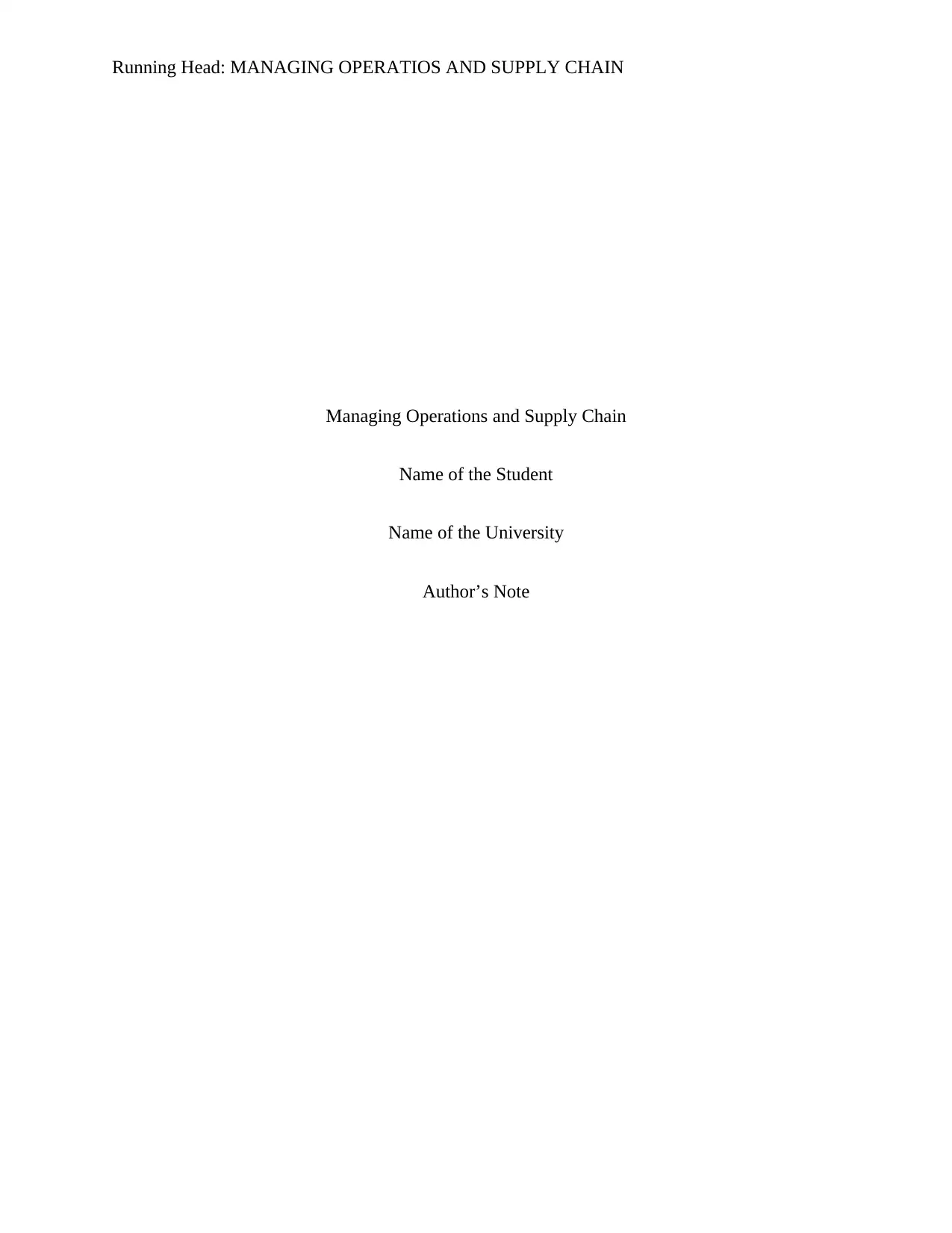
Running Head: MANAGING OPERATIOS AND SUPPLY CHAIN
Managing Operations and Supply Chain
Name of the Student
Name of the University
Author’s Note
Managing Operations and Supply Chain
Name of the Student
Name of the University
Author’s Note
Paraphrase This Document
Need a fresh take? Get an instant paraphrase of this document with our AI Paraphraser
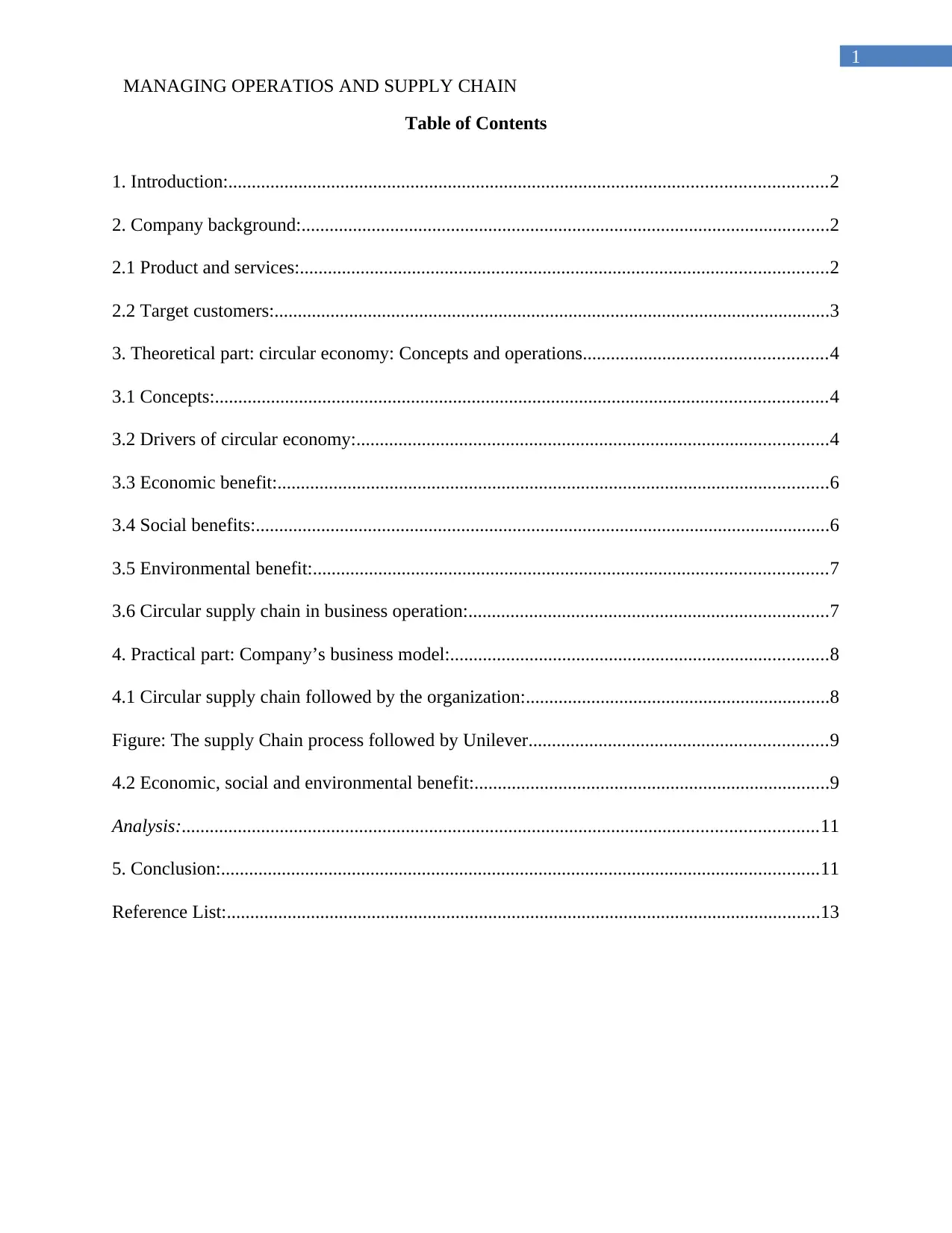
1
MANAGING OPERATIOS AND SUPPLY CHAIN
Table of Contents
1. Introduction:................................................................................................................................2
2. Company background:.................................................................................................................2
2.1 Product and services:.................................................................................................................2
2.2 Target customers:.......................................................................................................................3
3. Theoretical part: circular economy: Concepts and operations....................................................4
3.1 Concepts:...................................................................................................................................4
3.2 Drivers of circular economy:.....................................................................................................4
3.3 Economic benefit:......................................................................................................................6
3.4 Social benefits:...........................................................................................................................6
3.5 Environmental benefit:..............................................................................................................7
3.6 Circular supply chain in business operation:.............................................................................7
4. Practical part: Company’s business model:.................................................................................8
4.1 Circular supply chain followed by the organization:.................................................................8
Figure: The supply Chain process followed by Unilever................................................................9
4.2 Economic, social and environmental benefit:............................................................................9
Analysis:........................................................................................................................................11
5. Conclusion:................................................................................................................................11
Reference List:...............................................................................................................................13
MANAGING OPERATIOS AND SUPPLY CHAIN
Table of Contents
1. Introduction:................................................................................................................................2
2. Company background:.................................................................................................................2
2.1 Product and services:.................................................................................................................2
2.2 Target customers:.......................................................................................................................3
3. Theoretical part: circular economy: Concepts and operations....................................................4
3.1 Concepts:...................................................................................................................................4
3.2 Drivers of circular economy:.....................................................................................................4
3.3 Economic benefit:......................................................................................................................6
3.4 Social benefits:...........................................................................................................................6
3.5 Environmental benefit:..............................................................................................................7
3.6 Circular supply chain in business operation:.............................................................................7
4. Practical part: Company’s business model:.................................................................................8
4.1 Circular supply chain followed by the organization:.................................................................8
Figure: The supply Chain process followed by Unilever................................................................9
4.2 Economic, social and environmental benefit:............................................................................9
Analysis:........................................................................................................................................11
5. Conclusion:................................................................................................................................11
Reference List:...............................................................................................................................13
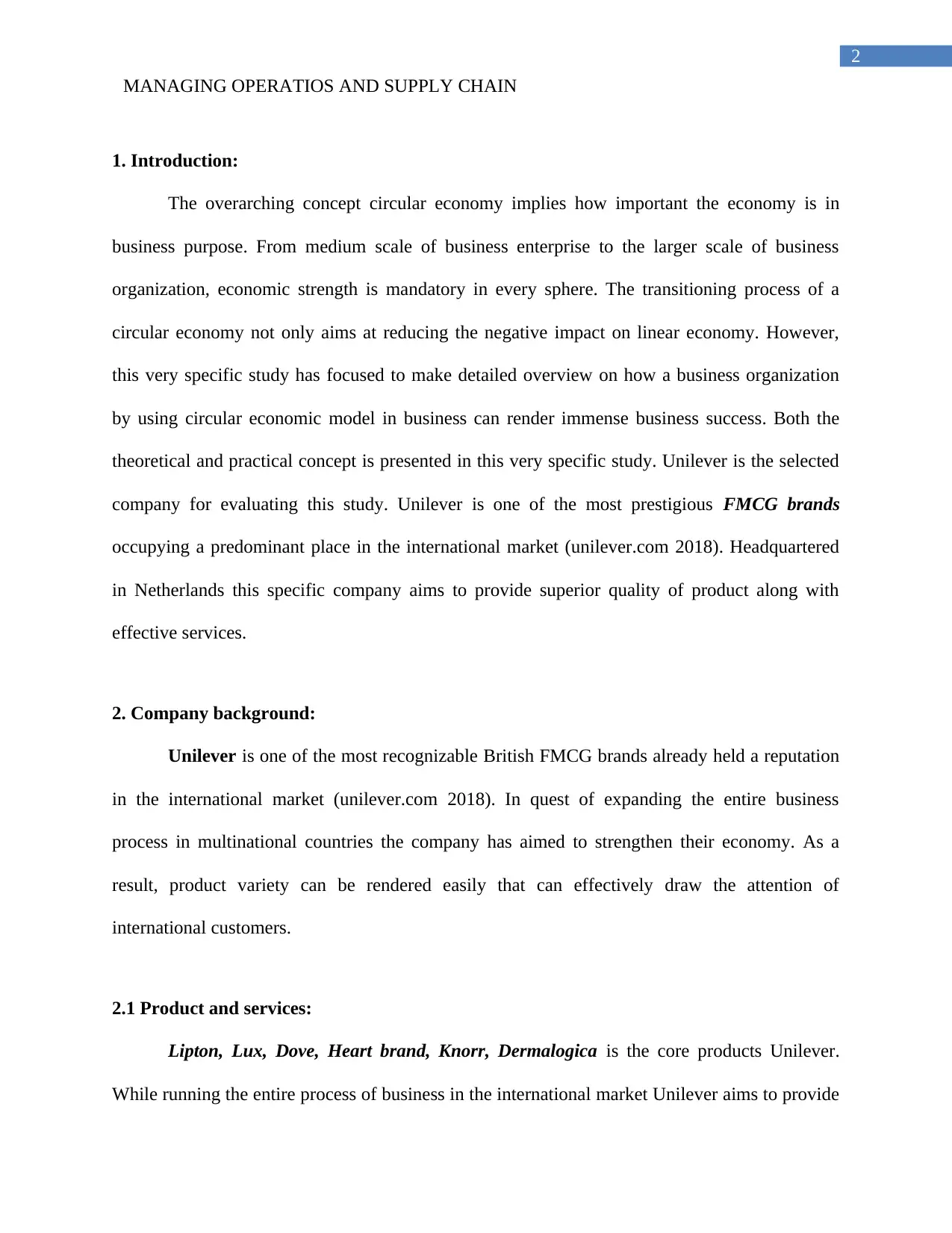
2
MANAGING OPERATIOS AND SUPPLY CHAIN
1. Introduction:
The overarching concept circular economy implies how important the economy is in
business purpose. From medium scale of business enterprise to the larger scale of business
organization, economic strength is mandatory in every sphere. The transitioning process of a
circular economy not only aims at reducing the negative impact on linear economy. However,
this very specific study has focused to make detailed overview on how a business organization
by using circular economic model in business can render immense business success. Both the
theoretical and practical concept is presented in this very specific study. Unilever is the selected
company for evaluating this study. Unilever is one of the most prestigious FMCG brands
occupying a predominant place in the international market (unilever.com 2018). Headquartered
in Netherlands this specific company aims to provide superior quality of product along with
effective services.
2. Company background:
Unilever is one of the most recognizable British FMCG brands already held a reputation
in the international market (unilever.com 2018). In quest of expanding the entire business
process in multinational countries the company has aimed to strengthen their economy. As a
result, product variety can be rendered easily that can effectively draw the attention of
international customers.
2.1 Product and services:
Lipton, Lux, Dove, Heart brand, Knorr, Dermalogica is the core products Unilever.
While running the entire process of business in the international market Unilever aims to provide
MANAGING OPERATIOS AND SUPPLY CHAIN
1. Introduction:
The overarching concept circular economy implies how important the economy is in
business purpose. From medium scale of business enterprise to the larger scale of business
organization, economic strength is mandatory in every sphere. The transitioning process of a
circular economy not only aims at reducing the negative impact on linear economy. However,
this very specific study has focused to make detailed overview on how a business organization
by using circular economic model in business can render immense business success. Both the
theoretical and practical concept is presented in this very specific study. Unilever is the selected
company for evaluating this study. Unilever is one of the most prestigious FMCG brands
occupying a predominant place in the international market (unilever.com 2018). Headquartered
in Netherlands this specific company aims to provide superior quality of product along with
effective services.
2. Company background:
Unilever is one of the most recognizable British FMCG brands already held a reputation
in the international market (unilever.com 2018). In quest of expanding the entire business
process in multinational countries the company has aimed to strengthen their economy. As a
result, product variety can be rendered easily that can effectively draw the attention of
international customers.
2.1 Product and services:
Lipton, Lux, Dove, Heart brand, Knorr, Dermalogica is the core products Unilever.
While running the entire process of business in the international market Unilever aims to provide
⊘ This is a preview!⊘
Do you want full access?
Subscribe today to unlock all pages.

Trusted by 1+ million students worldwide
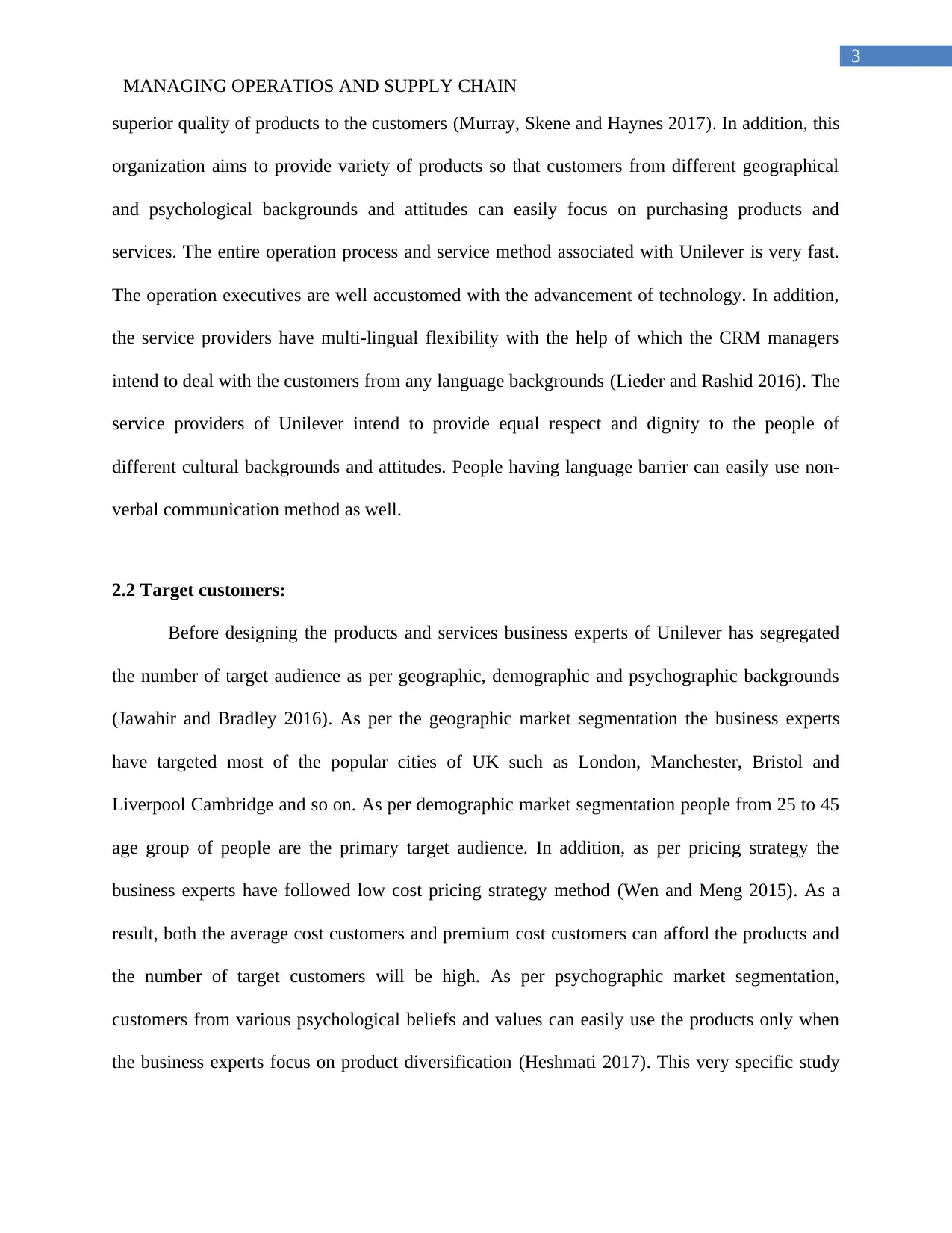
3
MANAGING OPERATIOS AND SUPPLY CHAIN
superior quality of products to the customers (Murray, Skene and Haynes 2017). In addition, this
organization aims to provide variety of products so that customers from different geographical
and psychological backgrounds and attitudes can easily focus on purchasing products and
services. The entire operation process and service method associated with Unilever is very fast.
The operation executives are well accustomed with the advancement of technology. In addition,
the service providers have multi-lingual flexibility with the help of which the CRM managers
intend to deal with the customers from any language backgrounds (Lieder and Rashid 2016). The
service providers of Unilever intend to provide equal respect and dignity to the people of
different cultural backgrounds and attitudes. People having language barrier can easily use non-
verbal communication method as well.
2.2 Target customers:
Before designing the products and services business experts of Unilever has segregated
the number of target audience as per geographic, demographic and psychographic backgrounds
(Jawahir and Bradley 2016). As per the geographic market segmentation the business experts
have targeted most of the popular cities of UK such as London, Manchester, Bristol and
Liverpool Cambridge and so on. As per demographic market segmentation people from 25 to 45
age group of people are the primary target audience. In addition, as per pricing strategy the
business experts have followed low cost pricing strategy method (Wen and Meng 2015). As a
result, both the average cost customers and premium cost customers can afford the products and
the number of target customers will be high. As per psychographic market segmentation,
customers from various psychological beliefs and values can easily use the products only when
the business experts focus on product diversification (Heshmati 2017). This very specific study
MANAGING OPERATIOS AND SUPPLY CHAIN
superior quality of products to the customers (Murray, Skene and Haynes 2017). In addition, this
organization aims to provide variety of products so that customers from different geographical
and psychological backgrounds and attitudes can easily focus on purchasing products and
services. The entire operation process and service method associated with Unilever is very fast.
The operation executives are well accustomed with the advancement of technology. In addition,
the service providers have multi-lingual flexibility with the help of which the CRM managers
intend to deal with the customers from any language backgrounds (Lieder and Rashid 2016). The
service providers of Unilever intend to provide equal respect and dignity to the people of
different cultural backgrounds and attitudes. People having language barrier can easily use non-
verbal communication method as well.
2.2 Target customers:
Before designing the products and services business experts of Unilever has segregated
the number of target audience as per geographic, demographic and psychographic backgrounds
(Jawahir and Bradley 2016). As per the geographic market segmentation the business experts
have targeted most of the popular cities of UK such as London, Manchester, Bristol and
Liverpool Cambridge and so on. As per demographic market segmentation people from 25 to 45
age group of people are the primary target audience. In addition, as per pricing strategy the
business experts have followed low cost pricing strategy method (Wen and Meng 2015). As a
result, both the average cost customers and premium cost customers can afford the products and
the number of target customers will be high. As per psychographic market segmentation,
customers from various psychological beliefs and values can easily use the products only when
the business experts focus on product diversification (Heshmati 2017). This very specific study
Paraphrase This Document
Need a fresh take? Get an instant paraphrase of this document with our AI Paraphraser
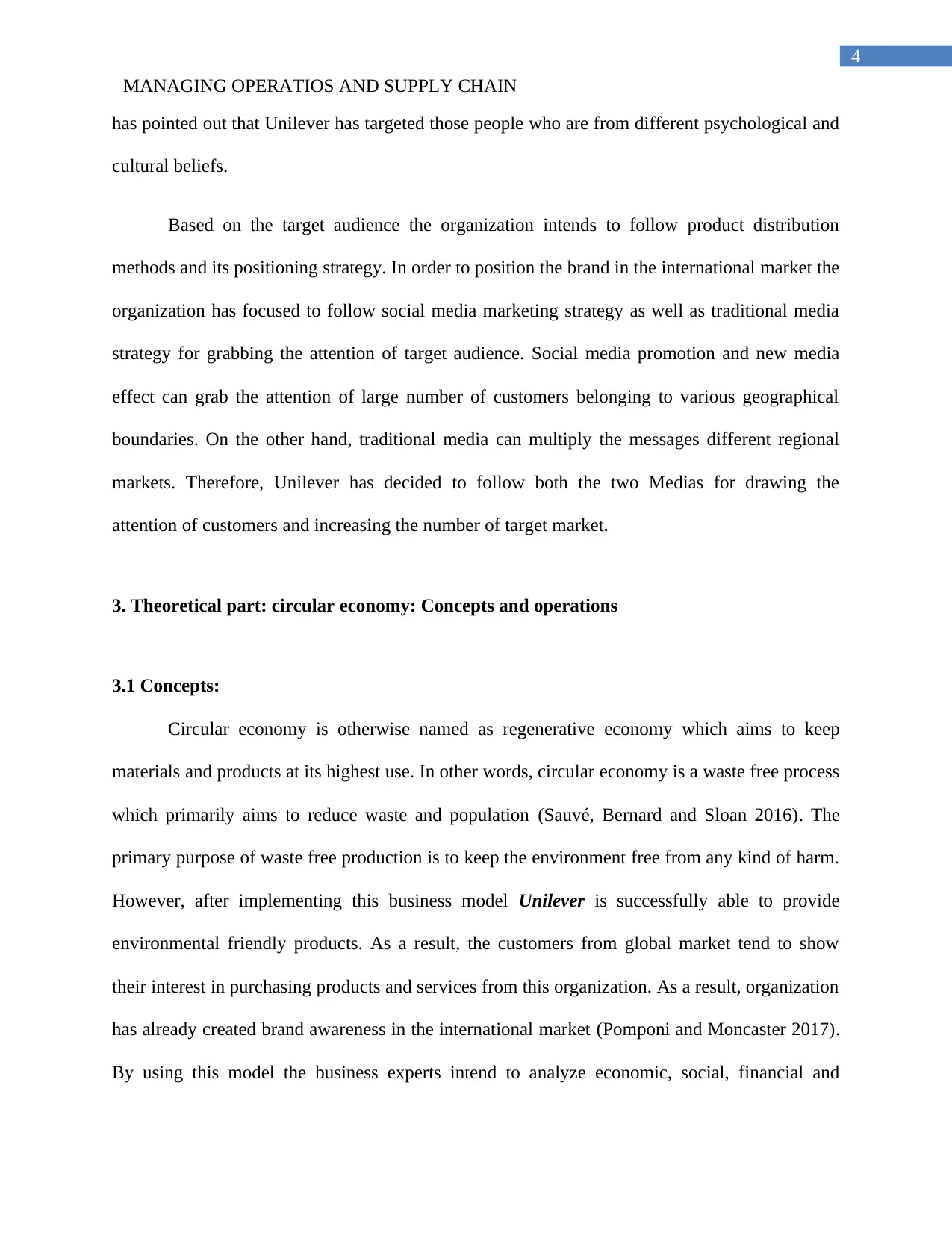
4
MANAGING OPERATIOS AND SUPPLY CHAIN
has pointed out that Unilever has targeted those people who are from different psychological and
cultural beliefs.
Based on the target audience the organization intends to follow product distribution
methods and its positioning strategy. In order to position the brand in the international market the
organization has focused to follow social media marketing strategy as well as traditional media
strategy for grabbing the attention of target audience. Social media promotion and new media
effect can grab the attention of large number of customers belonging to various geographical
boundaries. On the other hand, traditional media can multiply the messages different regional
markets. Therefore, Unilever has decided to follow both the two Medias for drawing the
attention of customers and increasing the number of target market.
3. Theoretical part: circular economy: Concepts and operations
3.1 Concepts:
Circular economy is otherwise named as regenerative economy which aims to keep
materials and products at its highest use. In other words, circular economy is a waste free process
which primarily aims to reduce waste and population (Sauvé, Bernard and Sloan 2016). The
primary purpose of waste free production is to keep the environment free from any kind of harm.
However, after implementing this business model Unilever is successfully able to provide
environmental friendly products. As a result, the customers from global market tend to show
their interest in purchasing products and services from this organization. As a result, organization
has already created brand awareness in the international market (Pomponi and Moncaster 2017).
By using this model the business experts intend to analyze economic, social, financial and
MANAGING OPERATIOS AND SUPPLY CHAIN
has pointed out that Unilever has targeted those people who are from different psychological and
cultural beliefs.
Based on the target audience the organization intends to follow product distribution
methods and its positioning strategy. In order to position the brand in the international market the
organization has focused to follow social media marketing strategy as well as traditional media
strategy for grabbing the attention of target audience. Social media promotion and new media
effect can grab the attention of large number of customers belonging to various geographical
boundaries. On the other hand, traditional media can multiply the messages different regional
markets. Therefore, Unilever has decided to follow both the two Medias for drawing the
attention of customers and increasing the number of target market.
3. Theoretical part: circular economy: Concepts and operations
3.1 Concepts:
Circular economy is otherwise named as regenerative economy which aims to keep
materials and products at its highest use. In other words, circular economy is a waste free process
which primarily aims to reduce waste and population (Sauvé, Bernard and Sloan 2016). The
primary purpose of waste free production is to keep the environment free from any kind of harm.
However, after implementing this business model Unilever is successfully able to provide
environmental friendly products. As a result, the customers from global market tend to show
their interest in purchasing products and services from this organization. As a result, organization
has already created brand awareness in the international market (Pomponi and Moncaster 2017).
By using this model the business experts intend to analyze economic, social, financial and
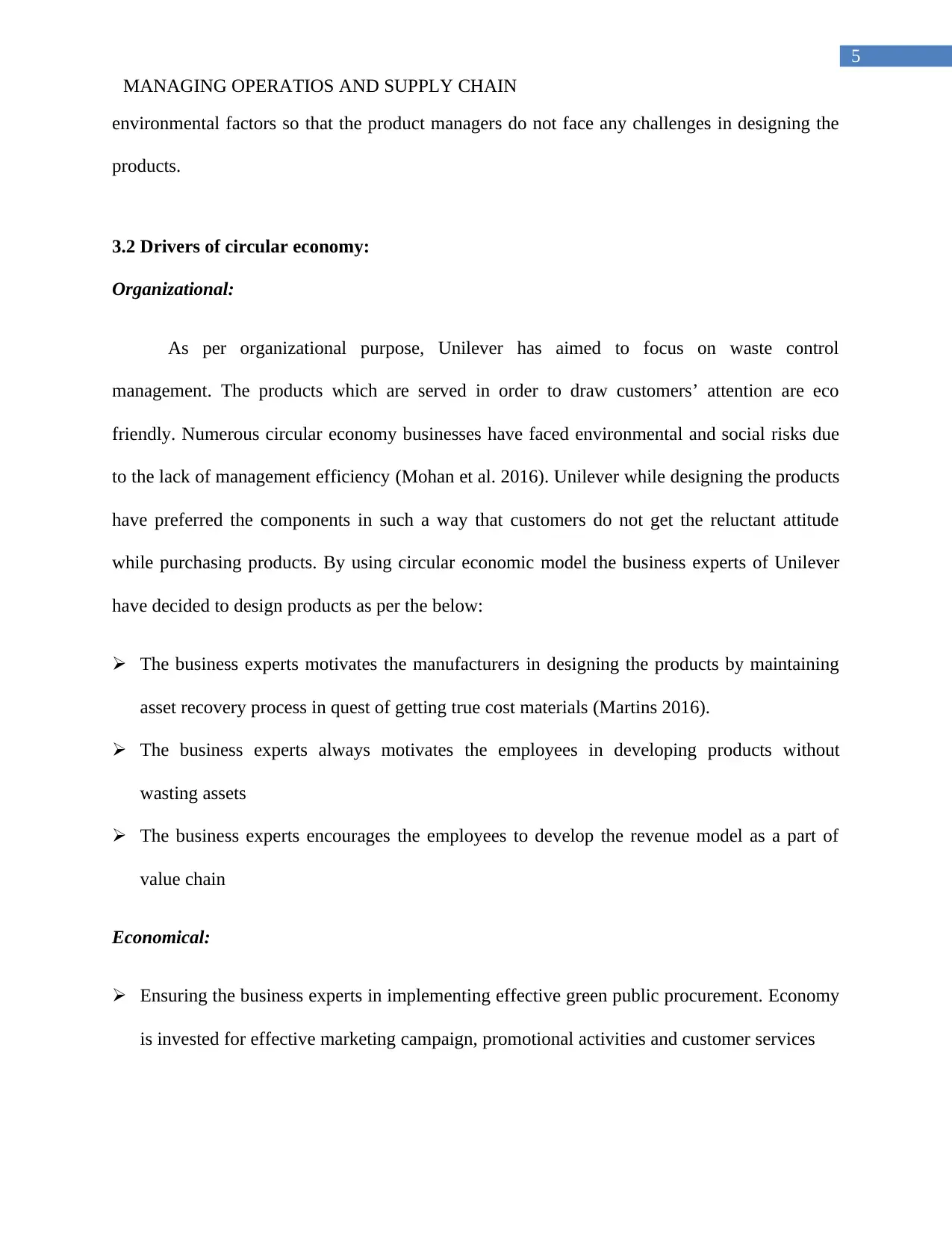
5
MANAGING OPERATIOS AND SUPPLY CHAIN
environmental factors so that the product managers do not face any challenges in designing the
products.
3.2 Drivers of circular economy:
Organizational:
As per organizational purpose, Unilever has aimed to focus on waste control
management. The products which are served in order to draw customers’ attention are eco
friendly. Numerous circular economy businesses have faced environmental and social risks due
to the lack of management efficiency (Mohan et al. 2016). Unilever while designing the products
have preferred the components in such a way that customers do not get the reluctant attitude
while purchasing products. By using circular economic model the business experts of Unilever
have decided to design products as per the below:
The business experts motivates the manufacturers in designing the products by maintaining
asset recovery process in quest of getting true cost materials (Martins 2016).
The business experts always motivates the employees in developing products without
wasting assets
The business experts encourages the employees to develop the revenue model as a part of
value chain
Economical:
Ensuring the business experts in implementing effective green public procurement. Economy
is invested for effective marketing campaign, promotional activities and customer services
MANAGING OPERATIOS AND SUPPLY CHAIN
environmental factors so that the product managers do not face any challenges in designing the
products.
3.2 Drivers of circular economy:
Organizational:
As per organizational purpose, Unilever has aimed to focus on waste control
management. The products which are served in order to draw customers’ attention are eco
friendly. Numerous circular economy businesses have faced environmental and social risks due
to the lack of management efficiency (Mohan et al. 2016). Unilever while designing the products
have preferred the components in such a way that customers do not get the reluctant attitude
while purchasing products. By using circular economic model the business experts of Unilever
have decided to design products as per the below:
The business experts motivates the manufacturers in designing the products by maintaining
asset recovery process in quest of getting true cost materials (Martins 2016).
The business experts always motivates the employees in developing products without
wasting assets
The business experts encourages the employees to develop the revenue model as a part of
value chain
Economical:
Ensuring the business experts in implementing effective green public procurement. Economy
is invested for effective marketing campaign, promotional activities and customer services
⊘ This is a preview!⊘
Do you want full access?
Subscribe today to unlock all pages.

Trusted by 1+ million students worldwide
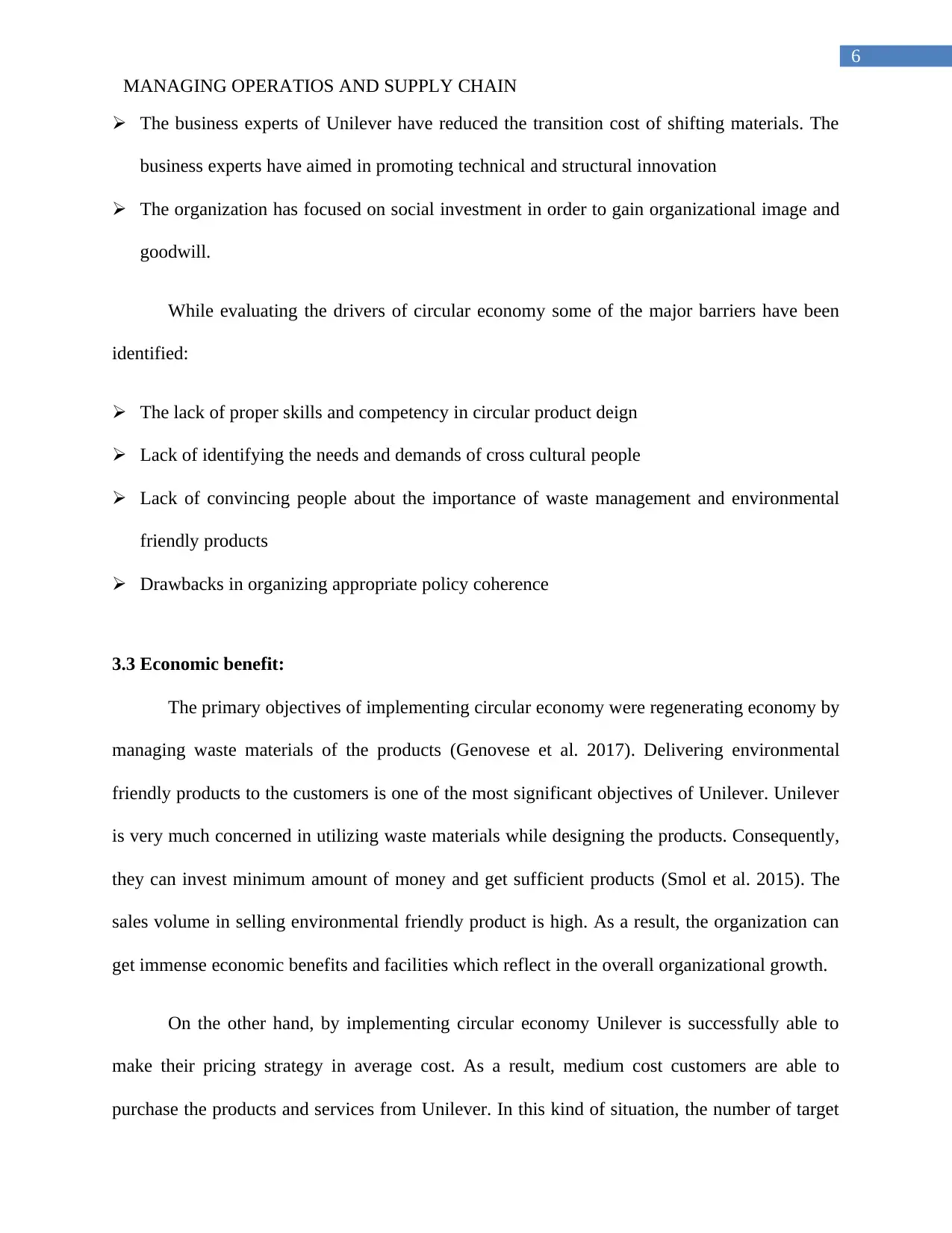
6
MANAGING OPERATIOS AND SUPPLY CHAIN
The business experts of Unilever have reduced the transition cost of shifting materials. The
business experts have aimed in promoting technical and structural innovation
The organization has focused on social investment in order to gain organizational image and
goodwill.
While evaluating the drivers of circular economy some of the major barriers have been
identified:
The lack of proper skills and competency in circular product deign
Lack of identifying the needs and demands of cross cultural people
Lack of convincing people about the importance of waste management and environmental
friendly products
Drawbacks in organizing appropriate policy coherence
3.3 Economic benefit:
The primary objectives of implementing circular economy were regenerating economy by
managing waste materials of the products (Genovese et al. 2017). Delivering environmental
friendly products to the customers is one of the most significant objectives of Unilever. Unilever
is very much concerned in utilizing waste materials while designing the products. Consequently,
they can invest minimum amount of money and get sufficient products (Smol et al. 2015). The
sales volume in selling environmental friendly product is high. As a result, the organization can
get immense economic benefits and facilities which reflect in the overall organizational growth.
On the other hand, by implementing circular economy Unilever is successfully able to
make their pricing strategy in average cost. As a result, medium cost customers are able to
purchase the products and services from Unilever. In this kind of situation, the number of target
MANAGING OPERATIOS AND SUPPLY CHAIN
The business experts of Unilever have reduced the transition cost of shifting materials. The
business experts have aimed in promoting technical and structural innovation
The organization has focused on social investment in order to gain organizational image and
goodwill.
While evaluating the drivers of circular economy some of the major barriers have been
identified:
The lack of proper skills and competency in circular product deign
Lack of identifying the needs and demands of cross cultural people
Lack of convincing people about the importance of waste management and environmental
friendly products
Drawbacks in organizing appropriate policy coherence
3.3 Economic benefit:
The primary objectives of implementing circular economy were regenerating economy by
managing waste materials of the products (Genovese et al. 2017). Delivering environmental
friendly products to the customers is one of the most significant objectives of Unilever. Unilever
is very much concerned in utilizing waste materials while designing the products. Consequently,
they can invest minimum amount of money and get sufficient products (Smol et al. 2015). The
sales volume in selling environmental friendly product is high. As a result, the organization can
get immense economic benefits and facilities which reflect in the overall organizational growth.
On the other hand, by implementing circular economy Unilever is successfully able to
make their pricing strategy in average cost. As a result, medium cost customers are able to
purchase the products and services from Unilever. In this kind of situation, the number of target
Paraphrase This Document
Need a fresh take? Get an instant paraphrase of this document with our AI Paraphraser
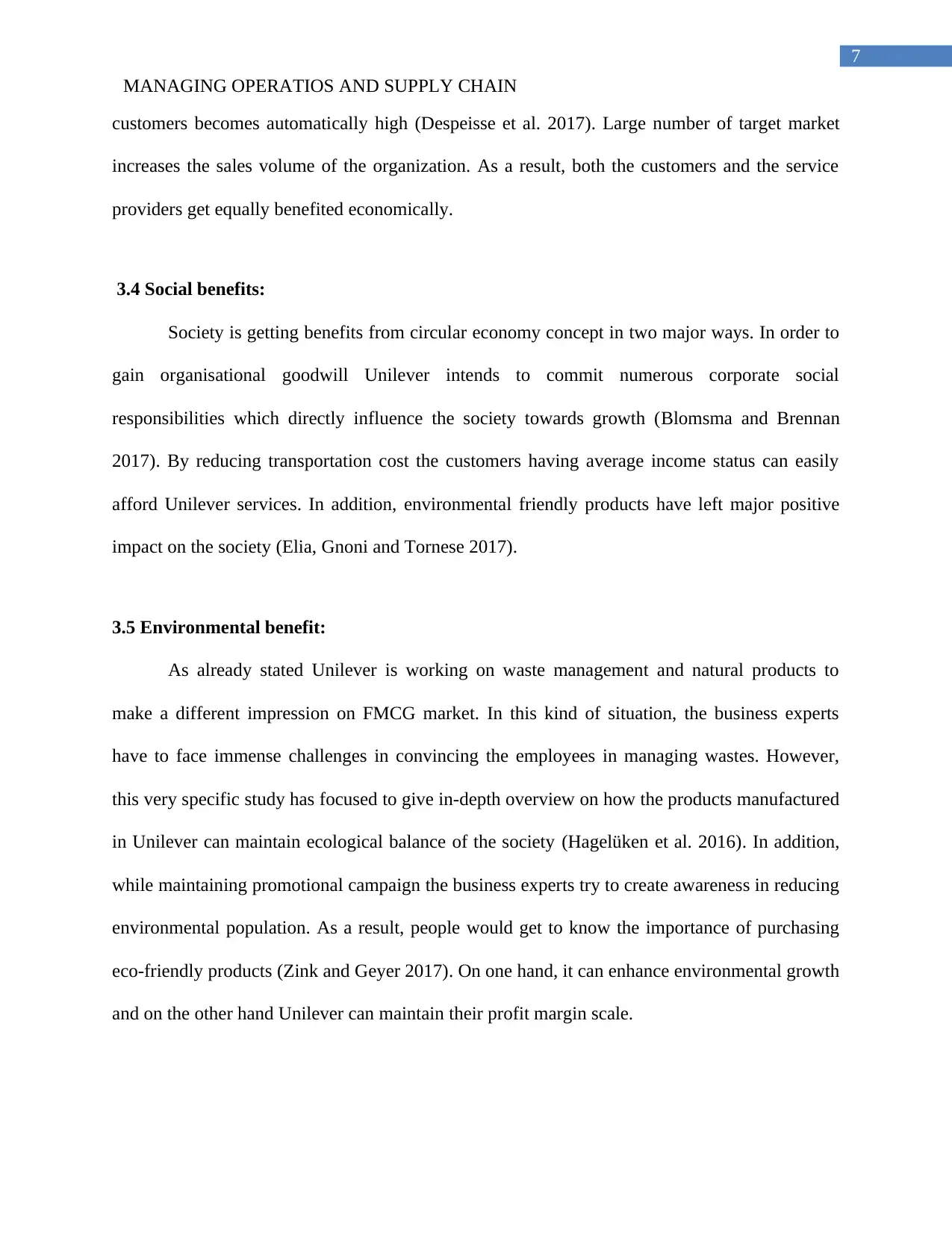
7
MANAGING OPERATIOS AND SUPPLY CHAIN
customers becomes automatically high (Despeisse et al. 2017). Large number of target market
increases the sales volume of the organization. As a result, both the customers and the service
providers get equally benefited economically.
3.4 Social benefits:
Society is getting benefits from circular economy concept in two major ways. In order to
gain organisational goodwill Unilever intends to commit numerous corporate social
responsibilities which directly influence the society towards growth (Blomsma and Brennan
2017). By reducing transportation cost the customers having average income status can easily
afford Unilever services. In addition, environmental friendly products have left major positive
impact on the society (Elia, Gnoni and Tornese 2017).
3.5 Environmental benefit:
As already stated Unilever is working on waste management and natural products to
make a different impression on FMCG market. In this kind of situation, the business experts
have to face immense challenges in convincing the employees in managing wastes. However,
this very specific study has focused to give in-depth overview on how the products manufactured
in Unilever can maintain ecological balance of the society (Hagelüken et al. 2016). In addition,
while maintaining promotional campaign the business experts try to create awareness in reducing
environmental population. As a result, people would get to know the importance of purchasing
eco-friendly products (Zink and Geyer 2017). On one hand, it can enhance environmental growth
and on the other hand Unilever can maintain their profit margin scale.
MANAGING OPERATIOS AND SUPPLY CHAIN
customers becomes automatically high (Despeisse et al. 2017). Large number of target market
increases the sales volume of the organization. As a result, both the customers and the service
providers get equally benefited economically.
3.4 Social benefits:
Society is getting benefits from circular economy concept in two major ways. In order to
gain organisational goodwill Unilever intends to commit numerous corporate social
responsibilities which directly influence the society towards growth (Blomsma and Brennan
2017). By reducing transportation cost the customers having average income status can easily
afford Unilever services. In addition, environmental friendly products have left major positive
impact on the society (Elia, Gnoni and Tornese 2017).
3.5 Environmental benefit:
As already stated Unilever is working on waste management and natural products to
make a different impression on FMCG market. In this kind of situation, the business experts
have to face immense challenges in convincing the employees in managing wastes. However,
this very specific study has focused to give in-depth overview on how the products manufactured
in Unilever can maintain ecological balance of the society (Hagelüken et al. 2016). In addition,
while maintaining promotional campaign the business experts try to create awareness in reducing
environmental population. As a result, people would get to know the importance of purchasing
eco-friendly products (Zink and Geyer 2017). On one hand, it can enhance environmental growth
and on the other hand Unilever can maintain their profit margin scale.
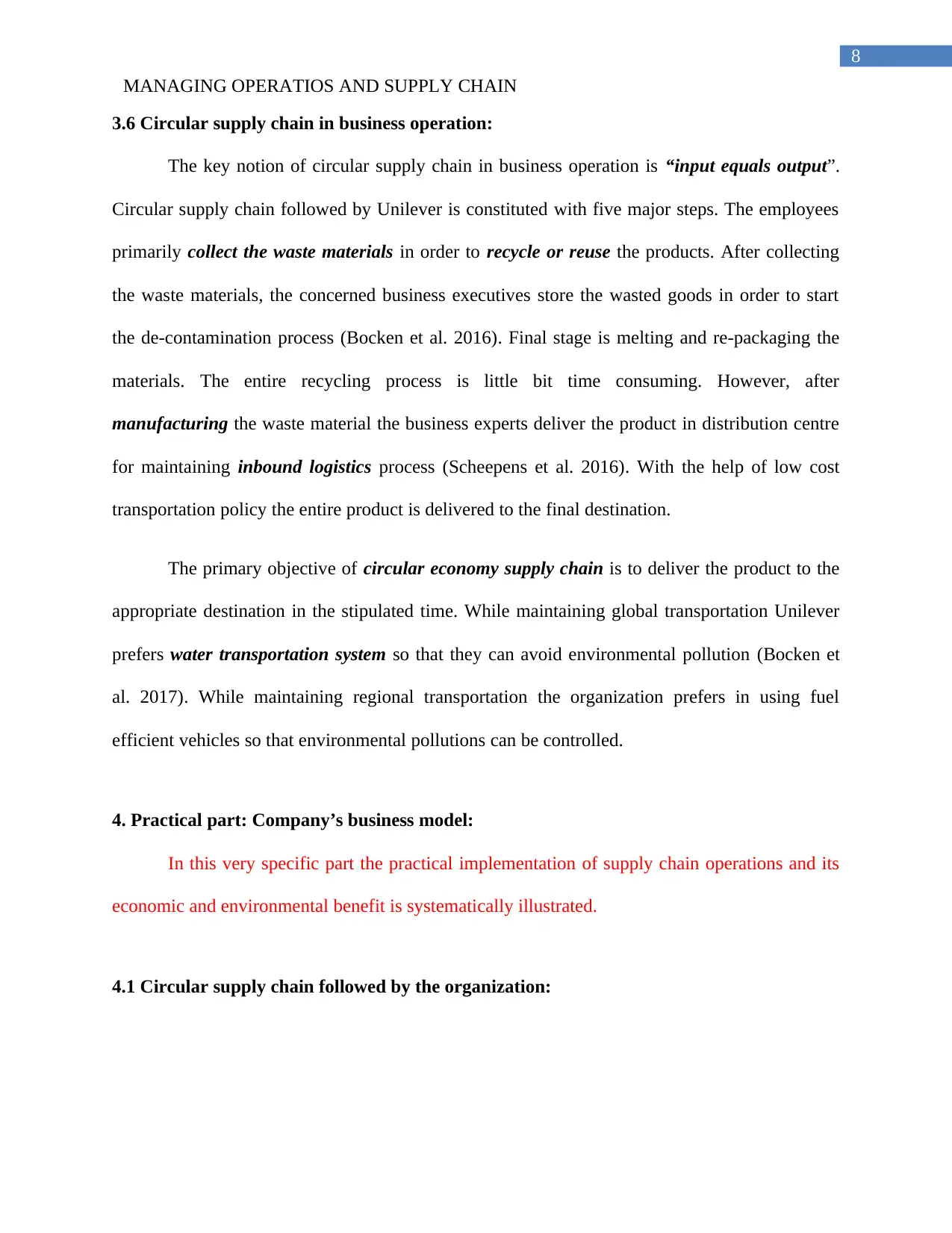
8
MANAGING OPERATIOS AND SUPPLY CHAIN
3.6 Circular supply chain in business operation:
The key notion of circular supply chain in business operation is “input equals output”.
Circular supply chain followed by Unilever is constituted with five major steps. The employees
primarily collect the waste materials in order to recycle or reuse the products. After collecting
the waste materials, the concerned business executives store the wasted goods in order to start
the de-contamination process (Bocken et al. 2016). Final stage is melting and re-packaging the
materials. The entire recycling process is little bit time consuming. However, after
manufacturing the waste material the business experts deliver the product in distribution centre
for maintaining inbound logistics process (Scheepens et al. 2016). With the help of low cost
transportation policy the entire product is delivered to the final destination.
The primary objective of circular economy supply chain is to deliver the product to the
appropriate destination in the stipulated time. While maintaining global transportation Unilever
prefers water transportation system so that they can avoid environmental pollution (Bocken et
al. 2017). While maintaining regional transportation the organization prefers in using fuel
efficient vehicles so that environmental pollutions can be controlled.
4. Practical part: Company’s business model:
In this very specific part the practical implementation of supply chain operations and its
economic and environmental benefit is systematically illustrated.
4.1 Circular supply chain followed by the organization:
MANAGING OPERATIOS AND SUPPLY CHAIN
3.6 Circular supply chain in business operation:
The key notion of circular supply chain in business operation is “input equals output”.
Circular supply chain followed by Unilever is constituted with five major steps. The employees
primarily collect the waste materials in order to recycle or reuse the products. After collecting
the waste materials, the concerned business executives store the wasted goods in order to start
the de-contamination process (Bocken et al. 2016). Final stage is melting and re-packaging the
materials. The entire recycling process is little bit time consuming. However, after
manufacturing the waste material the business experts deliver the product in distribution centre
for maintaining inbound logistics process (Scheepens et al. 2016). With the help of low cost
transportation policy the entire product is delivered to the final destination.
The primary objective of circular economy supply chain is to deliver the product to the
appropriate destination in the stipulated time. While maintaining global transportation Unilever
prefers water transportation system so that they can avoid environmental pollution (Bocken et
al. 2017). While maintaining regional transportation the organization prefers in using fuel
efficient vehicles so that environmental pollutions can be controlled.
4. Practical part: Company’s business model:
In this very specific part the practical implementation of supply chain operations and its
economic and environmental benefit is systematically illustrated.
4.1 Circular supply chain followed by the organization:
⊘ This is a preview!⊘
Do you want full access?
Subscribe today to unlock all pages.

Trusted by 1+ million students worldwide
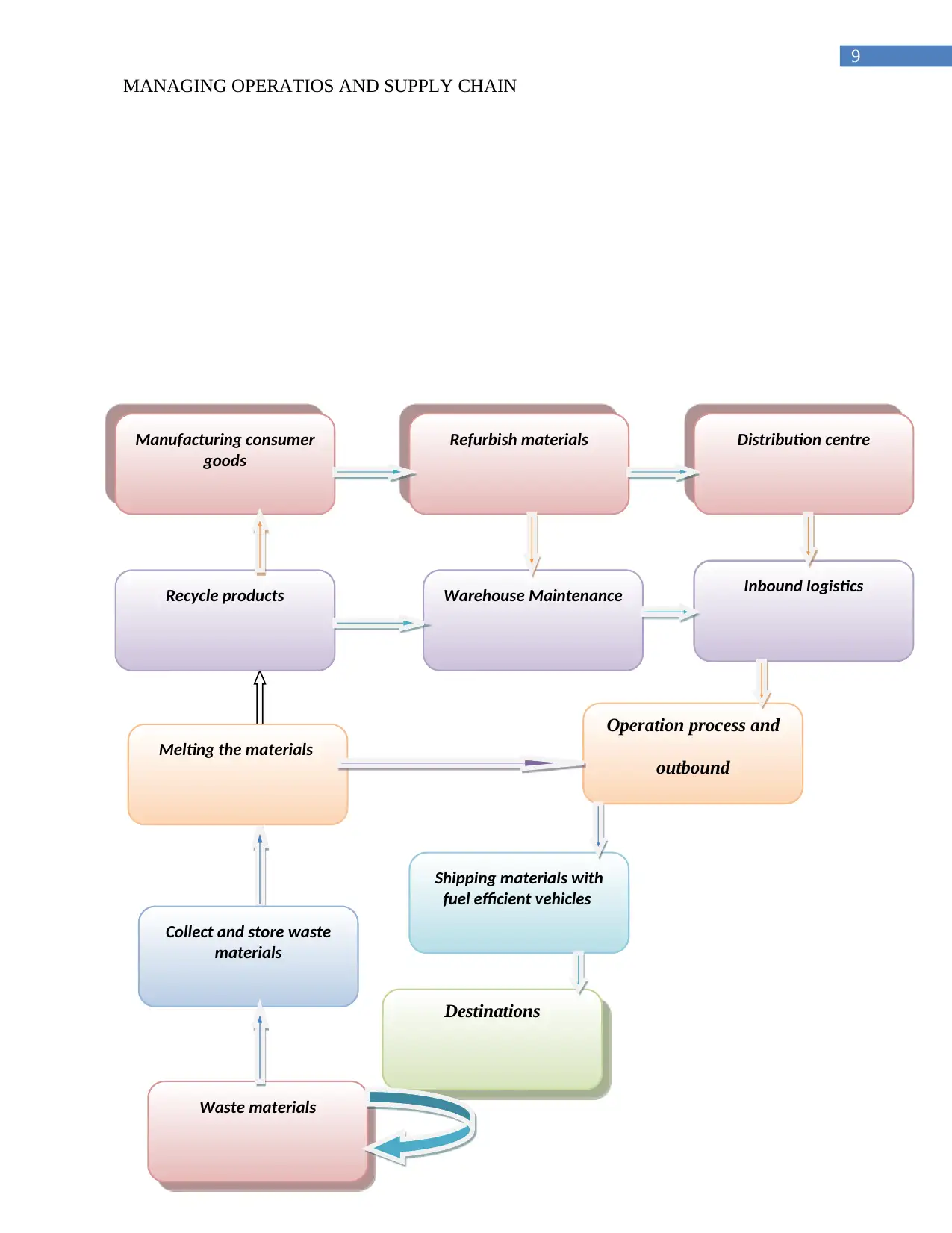
9
MANAGING OPERATIOS AND SUPPLY CHAIN
Operation process and
outbound
Destinations
Manufacturing consumer
goods
Shipping materials with
fuel efficient vehicles
Warehouse Maintenance
Distribution centreRefurbish materials
Inbound logistics
Waste materials
Collect and store waste
materials
Melting the materials
Recycle products
MANAGING OPERATIOS AND SUPPLY CHAIN
Operation process and
outbound
Destinations
Manufacturing consumer
goods
Shipping materials with
fuel efficient vehicles
Warehouse Maintenance
Distribution centreRefurbish materials
Inbound logistics
Waste materials
Collect and store waste
materials
Melting the materials
Recycle products
Paraphrase This Document
Need a fresh take? Get an instant paraphrase of this document with our AI Paraphraser
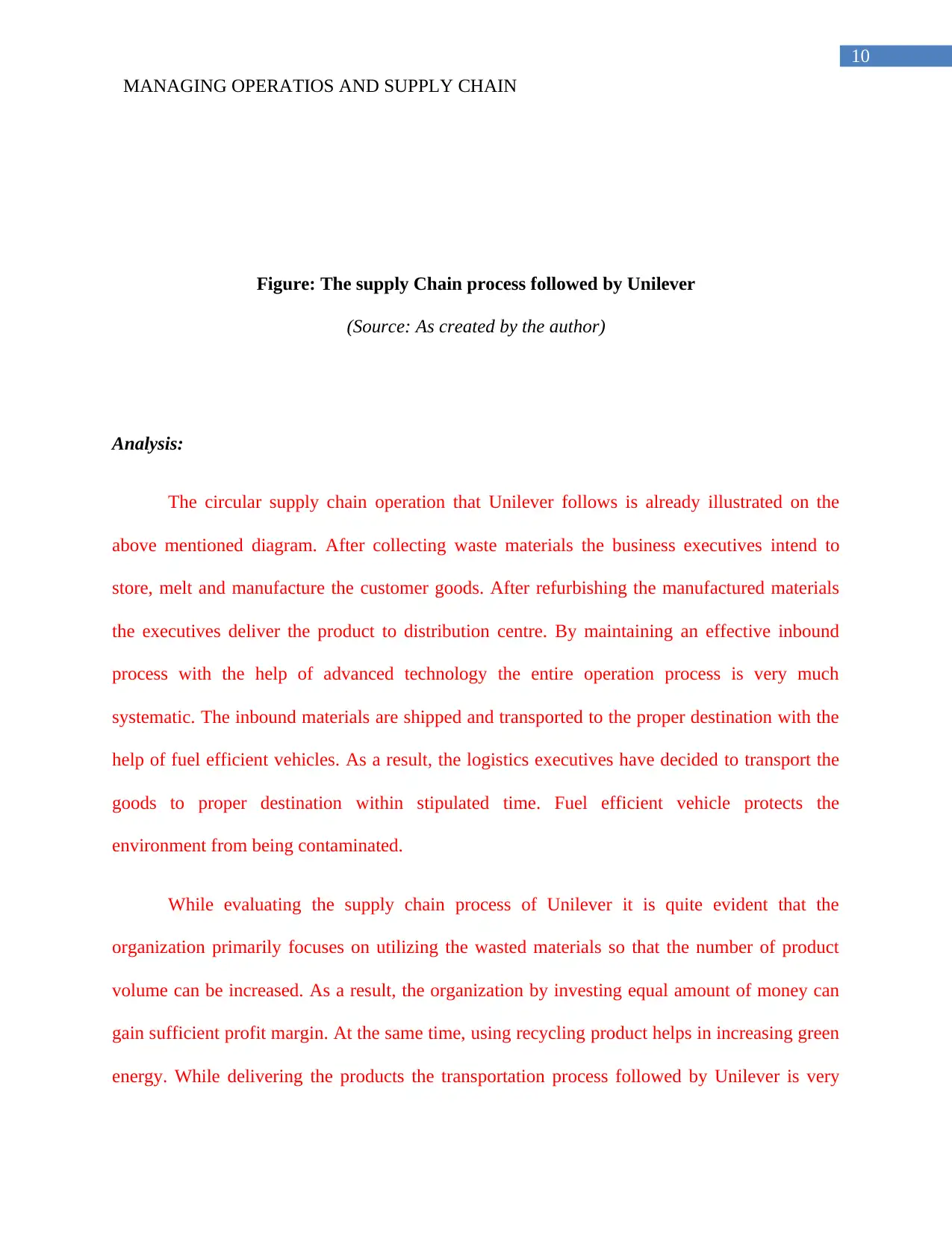
10
MANAGING OPERATIOS AND SUPPLY CHAIN
Figure: The supply Chain process followed by Unilever
(Source: As created by the author)
Analysis:
The circular supply chain operation that Unilever follows is already illustrated on the
above mentioned diagram. After collecting waste materials the business executives intend to
store, melt and manufacture the customer goods. After refurbishing the manufactured materials
the executives deliver the product to distribution centre. By maintaining an effective inbound
process with the help of advanced technology the entire operation process is very much
systematic. The inbound materials are shipped and transported to the proper destination with the
help of fuel efficient vehicles. As a result, the logistics executives have decided to transport the
goods to proper destination within stipulated time. Fuel efficient vehicle protects the
environment from being contaminated.
While evaluating the supply chain process of Unilever it is quite evident that the
organization primarily focuses on utilizing the wasted materials so that the number of product
volume can be increased. As a result, the organization by investing equal amount of money can
gain sufficient profit margin. At the same time, using recycling product helps in increasing green
energy. While delivering the products the transportation process followed by Unilever is very
MANAGING OPERATIOS AND SUPPLY CHAIN
Figure: The supply Chain process followed by Unilever
(Source: As created by the author)
Analysis:
The circular supply chain operation that Unilever follows is already illustrated on the
above mentioned diagram. After collecting waste materials the business executives intend to
store, melt and manufacture the customer goods. After refurbishing the manufactured materials
the executives deliver the product to distribution centre. By maintaining an effective inbound
process with the help of advanced technology the entire operation process is very much
systematic. The inbound materials are shipped and transported to the proper destination with the
help of fuel efficient vehicles. As a result, the logistics executives have decided to transport the
goods to proper destination within stipulated time. Fuel efficient vehicle protects the
environment from being contaminated.
While evaluating the supply chain process of Unilever it is quite evident that the
organization primarily focuses on utilizing the wasted materials so that the number of product
volume can be increased. As a result, the organization by investing equal amount of money can
gain sufficient profit margin. At the same time, using recycling product helps in increasing green
energy. While delivering the products the transportation process followed by Unilever is very
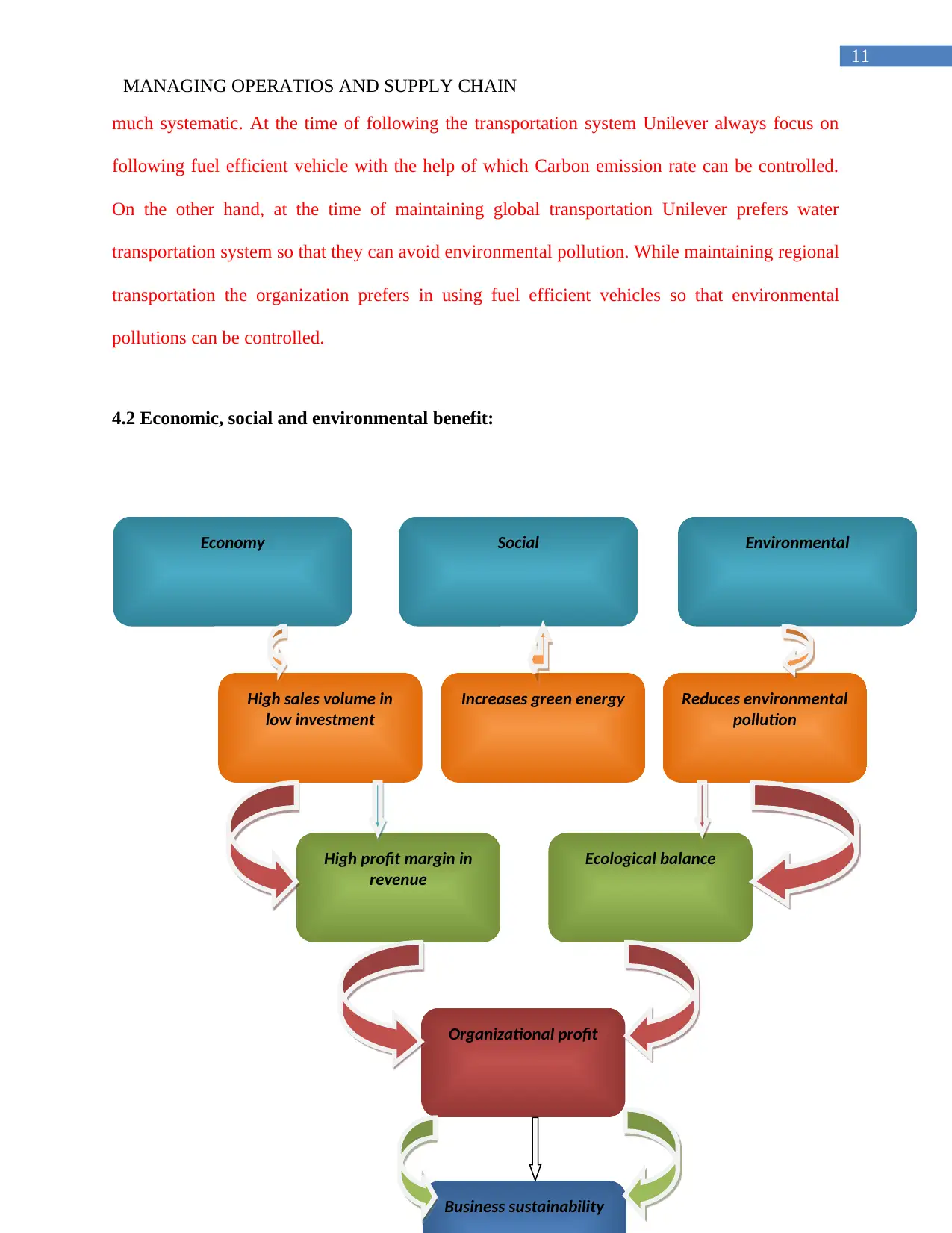
11
MANAGING OPERATIOS AND SUPPLY CHAIN
much systematic. At the time of following the transportation system Unilever always focus on
following fuel efficient vehicle with the help of which Carbon emission rate can be controlled.
On the other hand, at the time of maintaining global transportation Unilever prefers water
transportation system so that they can avoid environmental pollution. While maintaining regional
transportation the organization prefers in using fuel efficient vehicles so that environmental
pollutions can be controlled.
4.2 Economic, social and environmental benefit:
Economy Social Environmental
High sales volume in
low investment
Increases green energy Reduces environmental
pollution
High profit margin in
revenue
Ecological balance
Organizational profit
Business sustainability
MANAGING OPERATIOS AND SUPPLY CHAIN
much systematic. At the time of following the transportation system Unilever always focus on
following fuel efficient vehicle with the help of which Carbon emission rate can be controlled.
On the other hand, at the time of maintaining global transportation Unilever prefers water
transportation system so that they can avoid environmental pollution. While maintaining regional
transportation the organization prefers in using fuel efficient vehicles so that environmental
pollutions can be controlled.
4.2 Economic, social and environmental benefit:
Economy Social Environmental
High sales volume in
low investment
Increases green energy Reduces environmental
pollution
High profit margin in
revenue
Ecological balance
Organizational profit
Business sustainability
⊘ This is a preview!⊘
Do you want full access?
Subscribe today to unlock all pages.

Trusted by 1+ million students worldwide
1 out of 18
Related Documents
Your All-in-One AI-Powered Toolkit for Academic Success.
+13062052269
info@desklib.com
Available 24*7 on WhatsApp / Email
![[object Object]](/_next/static/media/star-bottom.7253800d.svg)
Unlock your academic potential
Copyright © 2020–2025 A2Z Services. All Rights Reserved. Developed and managed by ZUCOL.





